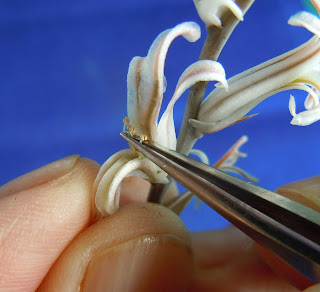고정 헤더 영역
상세 컨텐츠
본문
Marx의 홈페이지에 있는 하월시아 수정방법에 대해 정리하여 올려본다.
(http://www.gerhardmarx.com/ 참조)
Marx의 수정방법은 하월시아 꽃잎을 3장씩 위아래로 벌려서 암술을 조심하면서 암술 위로 자라올라온 수술을 한꺼번에
여러개를 잡아 뜯어내어서 다른 꽃의 암술위에 수분을 털어주는 방식을 사용하는 것으로 보인다.. 아래 그림과 사진 참조.
My pollination technique:
It was Mary Parisi who brought me one of the best gifts I ever received many years ago whe she gave me a pair of ‘Optivisor’magnifying glasses that clips over one’s head. This allows both hands free to work while looking through the magnifying lenses.
I use fine watchmakers’s forceps ( tweezers) to transfer the pollen and my method involves partially tearing open each of the flowers to be pollinated. Most Haworthia flowers open very easily when one pulls the upper three lobes and lower three lobes apart and then one can easily see the stamens with pollen and the stigma hidden lower down below them. I simply take the tips of the pollen-bearing stamens together in a bunch and transfer them to the stigma tip of an older flower on another plant. Care must be taken not to grab the stigma tip together with the stamen tips, but in most cases the stigma is situated well below the stamen tips. It is best to move pollen from younger flowers to the stigma tip of an older flower on the second plant. In most Haworthias the stigma tip cruves upward ( towards the upper perianth lobes) and one can slide the tweezer tip with bunch of pollen along the roof or the perianth and move it slightly down to press the pollen onto the stigma tip.
The photos below also illustrate my pollination technique:
|
| ||
| Simplified drawings explaining how to pollinate Haworthia flowers. |
 |
| Separate upper and lower perianth lobes to expose stamens. |
 |
| Remove pollen bearing anthers taking care not to damage style tip below them. |
 |
|
Insert tweezers and press pollen on top of upward-curving stigma tip. This is done on older flower of another plant.
|
This is how I also do pollination between pure species in my greenhouse and you may now wonder just how do I make sure that I know in the end which fruits contain hybrid seeds and which ones don’t.
My wife has an embroidery machnine and as a result has a huge collection of coloured threads which come in very handy. I would, for example, pollinate the flower of H. badia with that of H. splendens and then I would tie small pieces of the same red thread around each of the pollinated flowers. I may then pollinate another flower on the same H. badia plant with H. mutica, for example, and I will then use two pieces of green thread to mark the flowers. This way I can easily see what fruit resulted from what other plant’s pollen.
Hand-pollinating one’s plants in this way ensures very good fruit formation ( as the stigma tips get really flooded with a whole lot of pollen!) and I found that the fruits and even the seeds of plants in cultivation are larger and more viable than wild collected seed.
'하월시아 기르기' 카테고리의 다른 글
| 하월시아 룩우디(Lockwoodii)에 대한 글.. (0) | 2013.08.03 |
|---|---|
| Marx가 좋아하는 하월시아 몇아이.. (0) | 2013.08.02 |
| Marx의 하월시아 Hybrid에 대한 생각읽기.. (0) | 2013.08.02 |
| Gerhard Marx의 홈페이지를 찾아서.. (0) | 2013.08.02 |
| 한여름의 츠카하라만상 스물두번째.. (0) | 2013.07.31 |






댓글 영역